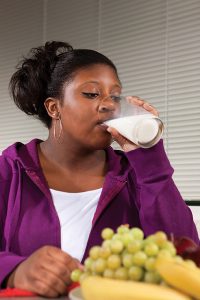Unit 1 – Food Safety
1.1 Introduction
Food and Nutrition Go Hand in Hand
A study of nutrition is incomplete without discussing food — the two go hand in hand. Food is the delivery vehicle of nutrients to our bodies. We need nutrients for growth and repair of our body tissues, as a source of energy, and to stay healthy. And foods need the various nutrients for their color, flavor, texture, and even shape.
For example, it’s well known that milk is an excellent source of calcium and protein, both are needed to build strong bones. When we look at a glass of milk, the white color results from light refracting and scattering on the milk’s calcium and proteins.
The sweet flavors of grapes, melons, and oranges are related to the fructose, also known as fruit sugar. And that sweetness quenches our craving for sugary foods, and may prevent us from grabbing a candy bar or frosted cup cake.

And everyone knows that eating carrots provides us with the vitamin A needed for vision. That vitamin A is beta-carotene, the bright orange pigment that gives carrots their vibrant color. (And eating too many can make our skin turn orange!)
Adding eggs to pancakes provides a high quality protein that is needed to help maintain our muscles. That muscle-building protein in eggs adds moisture, color, and structure to the finished pancakes.
We begin our exploration of this food/nutrition duo in the kitchen. We hope that you will try preparing many of the nutrient packed foods discussed throughout the book without catching the kitchen on fire or cutting off a finger. Therefore, we begin this unit with safe practices in the kitchen, followed by how to make sure that our foods are safe to consume and not plagued with contaminants.
Unit Learning Objectives
- Demonstrate kitchen safety practices including fire safety and knife skills.
- Recognize the food safety standards used to ensure safe food systems.
- Compare the roles that the CDC, USDA, FDA and EPA have on the US food supply and health of the nation.
- Describe food processing and preservation techniques designed to improve the safety of our food supply.
- Explain how safe food handling practices help prevent foodborne illnesses.
- List and discuss FDA’s fours steps for safe food handling.
- Describe the three major types of food contamination and causes of each.
- Identify the most common causes of foodborne illness and populations at risk for illnesses.
- Explain the meaning of “FAT TOM” as related to food safety.
- Compare USDA’s Danger Zone temperature range for home use to the Danger Zone range recommended by ServSafe®.
- Identify foods that are potentially hazardous and those that are not.
- Describe consumer-level techniques for avoiding foodborne illnesses.
- Explain the differences between foods derived from bioengineered seeds to those grown organically.
Carbohydrates, proteins, lipids, vitamins, minerals and water.
Harmful substance in a food that causes harm to the body. They may be physical contaminants such as hair or class, chemical contaminants such as mercury or pesticide residue, or biological such as bacteria, mold, or parasites.

